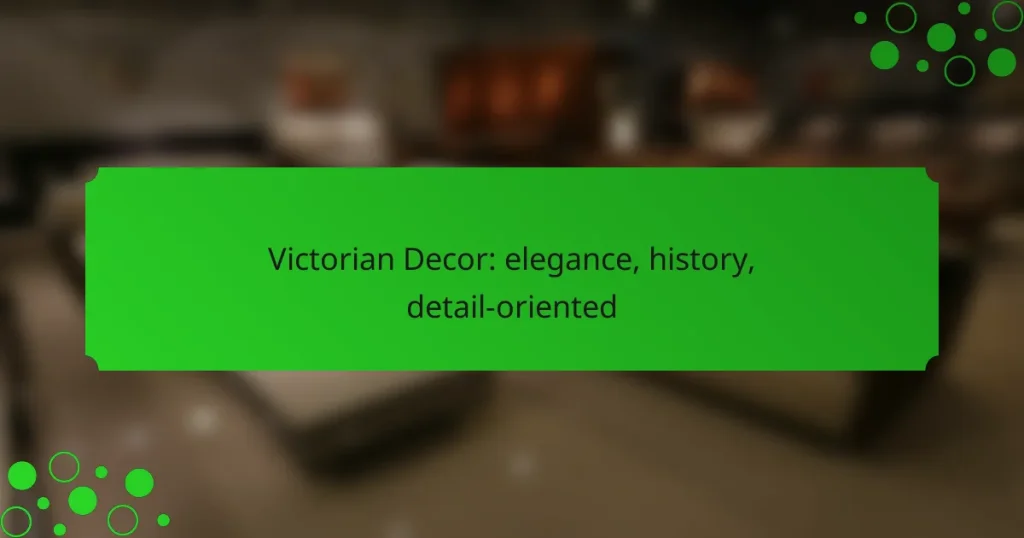
Victorian Decor: elegance, history, detail-oriented
Victorian decor embodies a unique blend of elegance and history, characterized by its ornate details…
Home decor styles encompass a wide range of aesthetics, from Modern and Traditional to Industrial, Scandinavian, and Bohemian. Each style brings its own unique characteristics, allowing you to create a living space that reflects your personal taste and lifestyle. By considering your preferences, space, and budget, you can select a decor style that enhances your home and showcases your individuality.

Victorian decor embodies a unique blend of elegance and history, characterized by its ornate details and rich color palettes. Emerging during the reign of Queen Victoria in the 19th century, this design style reflects a deep appreciation for craftsmanship and opulence. By incorporating Victorian elements into modern spaces, one can achieve a sophisticated aesthetic that…

Farmhouse decor beautifully merges rustic charm with modern aesthetics, creating inviting spaces that feel both cozy and stylish. By focusing on natural materials and a cohesive color palette, you can transform your home into a warm retreat. Embrace DIY projects that highlight vintage elements, and explore local antique shops and online marketplaces for unique finds…

Rustic decor brings a sense of authenticity, warmth, and simplicity to homes, making it a popular choice for many. By incorporating natural materials, local craftsmanship, and vintage pieces, you can create a cozy atmosphere that invites relaxation and comfort. Embrace the charm of rustic style to enhance your living space with unique elements that reflect…

Contemporary decor embodies a dynamic blend of adaptability, trendiness, and innovation, making it ideal for modern living spaces. By prioritizing versatile designs and smart solutions, homeowners can create environments that are both stylish and functional. Embracing trends like biophilic design and minimalist aesthetics allows for a seamless integration of comfort and technology, ensuring spaces remain…

Modern decor embraces a harmonious blend of sustainable materials, smart technology, and open layouts to create stylish and functional living spaces. By prioritizing eco-friendly options, integrating innovative technologies, and promoting seamless flow, contemporary design enhances both aesthetics and everyday convenience. This approach not only elevates the visual appeal but also fosters a more inviting and…

Art Deco decor is a captivating design style characterized by its striking geometric patterns, opulent materials, and vibrant colors. Emerging in the early 20th century, this aesthetic emphasizes elegance and sophistication, making it a favored choice for enhancing both residential and commercial spaces. By thoughtfully integrating these elements, you can create a cohesive and stylish…

Eclectic decor is a vibrant approach to interior design that celebrates creativity and individuality by merging various styles, colors, and textures. This unique blend allows you to curate a personalized space that reflects your diverse tastes and experiences, making your home truly one-of-a-kind. How to incorporate eclectic decor in your home? Incorporating eclectic decor in…

Bohemian decor is a celebration of personal expression, characterized by an eclectic mix of vibrant colors, patterns, and textures that create a warm and inviting atmosphere. By incorporating cultural influences and unique items that reflect individual experiences, this style fosters a comfortable space that truly embodies one’s personality and love for diversity. How to incorporate…

Contemporary decor trends focus on creating open spaces that promote light and flow, while making bold statements through unique furniture and striking artwork. Homeowners are increasingly blending functionality with aesthetics, opting for designs that reflect their personal style and incorporate sustainable materials. This approach not only enhances the visual appeal of a space but also…
Popular home decor styles in the UK include Modern, Traditional, Industrial, Scandinavian, and Bohemian. Each style offers unique characteristics and influences that cater to different tastes and preferences.
Modern style emphasizes clean lines, minimalism, and functional furniture. It often features neutral color palettes with bold accents, focusing on open spaces and natural light.
When adopting a modern style, consider using materials like glass, metal, and concrete. Avoid excessive ornamentation to maintain a sleek and uncluttered look.
Traditional style is characterized by classic furnishings, rich colors, and intricate details. It often incorporates antique pieces and ornate decorations, creating a warm and inviting atmosphere.
To achieve a traditional look, opt for wooden furniture, patterned fabrics, and traditional artwork. Layering textures and using warm lighting can enhance the cozy feel of this style.
Industrial style draws inspiration from warehouses and factories, featuring raw materials like exposed brick, metal, and reclaimed wood. This style embraces a rugged aesthetic with a focus on functionality.
When designing an industrial space, consider open floor plans and large windows. Use vintage or salvaged items as decor to add character while keeping the overall look cohesive.
Scandinavian style is known for its simplicity, functionality, and connection to nature. It often includes light colors, natural materials, and a focus on creating a cozy environment.
Incorporate elements like wooden furniture, soft textiles, and plenty of plants to achieve this style. Prioritize decluttering and organization to maintain a serene and airy space.
Bohemian style is eclectic and vibrant, characterized by a mix of colors, patterns, and textures. It often reflects personal experiences and travels, creating a unique and artistic atmosphere.
To embrace a bohemian look, layer rugs, mix various textiles, and display art and souvenirs. Don't shy away from bold colors and unconventional arrangements to express individuality.
Choosing a home decor style involves understanding your personal preferences, the characteristics of your space, and your budget. By evaluating these factors, you can select a style that enhances your living environment while reflecting your individuality.
Your personal taste is the foundation of your home decor style. Consider what colors, patterns, and materials resonate with you. Look for inspiration in magazines, online platforms, or even nature to identify elements that you are drawn to.
Make a mood board with images that inspire you. This visual representation can help clarify your preferences and guide your decisions as you explore different styles, such as modern, rustic, or eclectic.
The size and layout of your space significantly influence your decor choices. Assess the dimensions of each room and how the furniture will fit within the space. For example, a small room may benefit from a minimalist style to avoid clutter.
Think about the flow of movement within your home. Ensure that your chosen decor style complements the existing architecture and enhances the functionality of the space. Open layouts may suit contemporary styles, while traditional homes might benefit from classic designs.
Your budget plays a crucial role in determining your home decor style. Establish a realistic budget that includes furniture, decor items, and potential renovations. This will help you narrow down your options and avoid overspending.
Consider prioritizing key pieces that make a statement while opting for more affordable options for smaller decor items. For instance, investing in a quality sofa can anchor a room, while decorative cushions or artwork can be sourced at lower prices to complement the overall look.
Each home decor style has distinct characteristics that define its aesthetic and functionality. Understanding these features can help you choose a style that aligns with your preferences and lifestyle.
Modern style is characterized by clean lines, minimalism, and a focus on functionality. It often incorporates neutral color palettes, open spaces, and natural materials like wood and metal.
Furniture in modern decor tends to be sleek and simple, avoiding ornate details. Accessories are kept to a minimum, emphasizing the beauty of the space itself.
Traditional style is rooted in classic design elements, featuring rich colors, elegant furnishings, and ornate details. This style often includes dark wood furniture, patterned fabrics, and decorative moldings.
Rooms designed in a traditional style typically have a warm and inviting atmosphere, often enhanced by the use of antiques and heirloom pieces that tell a story.
Industrial style draws inspiration from warehouses and factories, showcasing raw materials and an unfinished look. Key elements include exposed brick, metal fixtures, and reclaimed wood.
This style often emphasizes open spaces with high ceilings and large windows, creating a spacious and airy environment. Furniture tends to be functional and robust, often with a vintage or rustic feel.
Scandinavian style is known for its simplicity, functionality, and connection to nature. It features light color schemes, natural materials, and an emphasis on minimalism.
Common elements include wooden floors, cozy textiles, and plenty of natural light. This style promotes a sense of warmth and comfort, often incorporating plants and organic shapes.
Bohemian style is eclectic and vibrant, characterized by a mix of colors, patterns, and textures. It often includes vintage furniture, handmade items, and global influences.
This style encourages personal expression, allowing for a variety of decor elements that reflect individual tastes. Layered textiles, such as rugs and cushions, are common, creating a cozy and inviting atmosphere.
Mixing and matching home decor styles involves combining different design elements to create a cohesive look. Focus on harmonizing colors, textures, and themes to achieve a balanced aesthetic that reflects your personal taste.
Start by identifying common elements among the styles you wish to combine. Look for shared colors, materials, or shapes that can serve as a unifying factor. For instance, if you are blending modern and rustic styles, you might use wood accents alongside sleek metal fixtures.
Consider creating a mood board to visualize how different elements interact. This can help you see which pieces complement each other and which may clash. Aim for a few key items that embody the essence of each style while maintaining a cohesive overall look.
Balancing colors and textures is crucial when mixing decor styles. Choose a color palette that includes both dominant and accent colors to create visual interest without overwhelming the space. For example, a neutral base can be accented with bold colors from various styles.
Incorporate a variety of textures to add depth. Pair soft fabrics like velvet or linen with harder materials such as glass or metal. This contrast can enhance the overall design and make the space feel more inviting. Remember to keep the balance in mind; too many competing textures can create chaos rather than harmony.
The best places to shop for home decor in the UK include a mix of online retailers, local boutiques, and home improvement stores. Each option offers unique selections and price ranges, catering to different tastes and budgets.
Online retailers are a convenient option for home decor shopping, providing a vast selection of items from various brands. Websites like Wayfair, Amazon, and Made.com allow you to browse and compare products easily, often with customer reviews to guide your choices.
When shopping online, consider shipping costs and delivery times, as these can vary significantly. Look for retailers that offer free returns to ensure you can send back items that don’t meet your expectations.
Local boutiques offer a curated selection of home decor that often reflects regional styles and craftsmanship. Shopping at these stores can provide a more personalized experience, with knowledgeable staff who can offer design advice and unique finds.
Support local businesses by visiting markets or fairs where artisans showcase their work. This not only helps the community but also allows you to discover one-of-a-kind pieces that may not be available elsewhere.
Home improvement stores like B&Q and Wickes are excellent for practical home decor items, including furniture, lighting, and accessories. These stores often have a wide range of products at competitive prices, making them suitable for budget-conscious shoppers.
When visiting home improvement stores, take advantage of seasonal sales and promotions. Many stores offer discounts on decor items during holidays or special events, so timing your purchase can lead to significant savings.